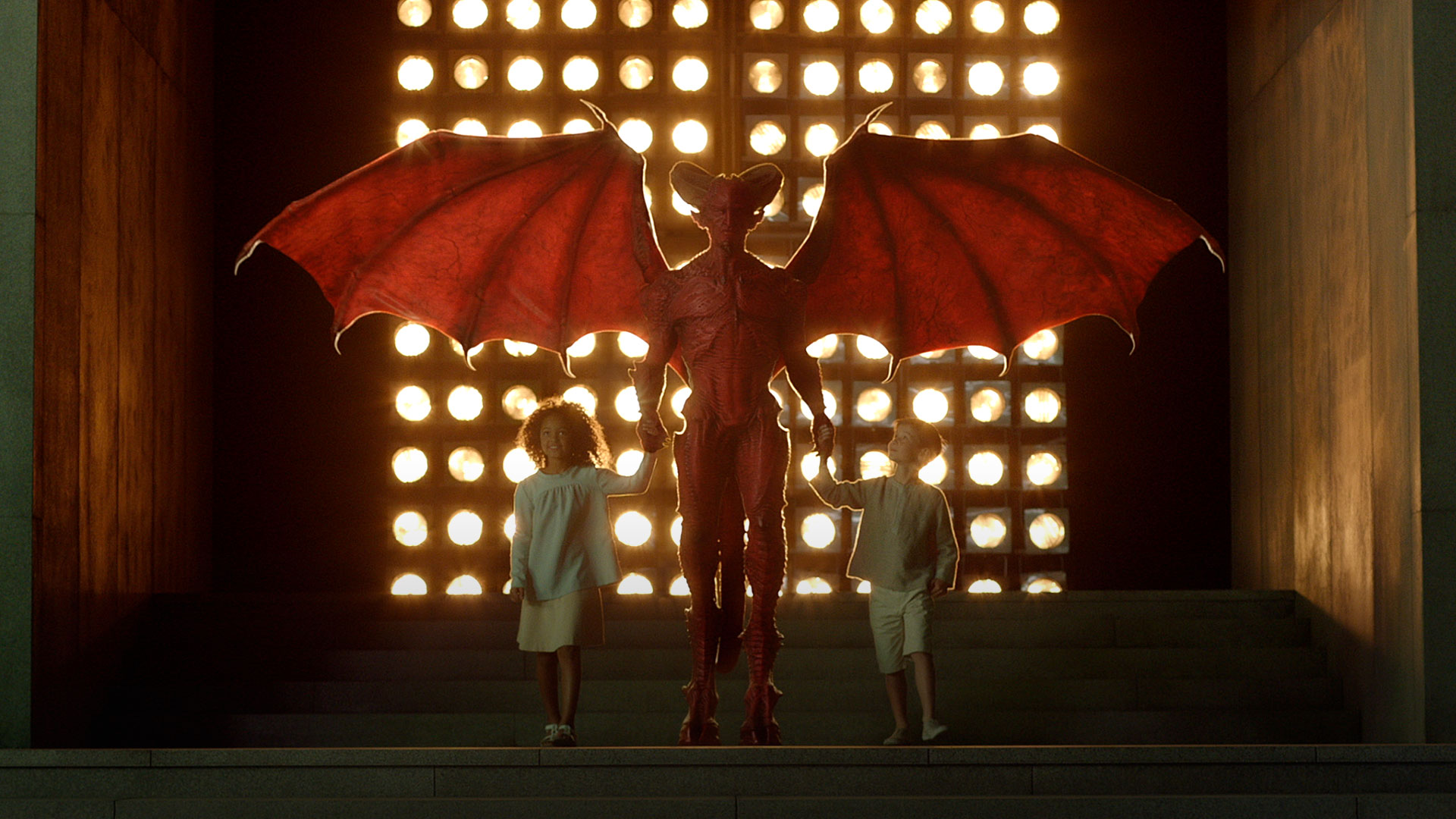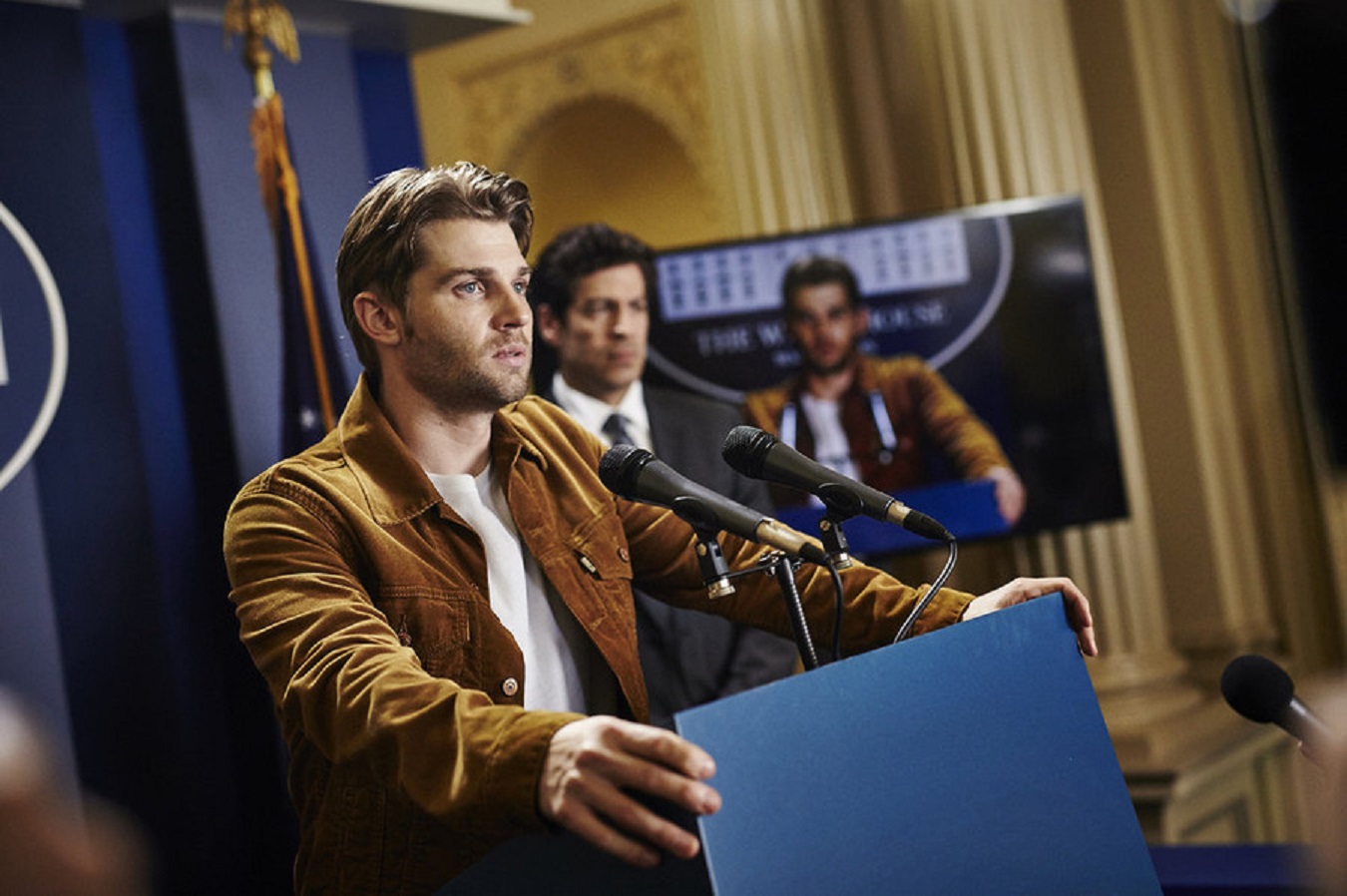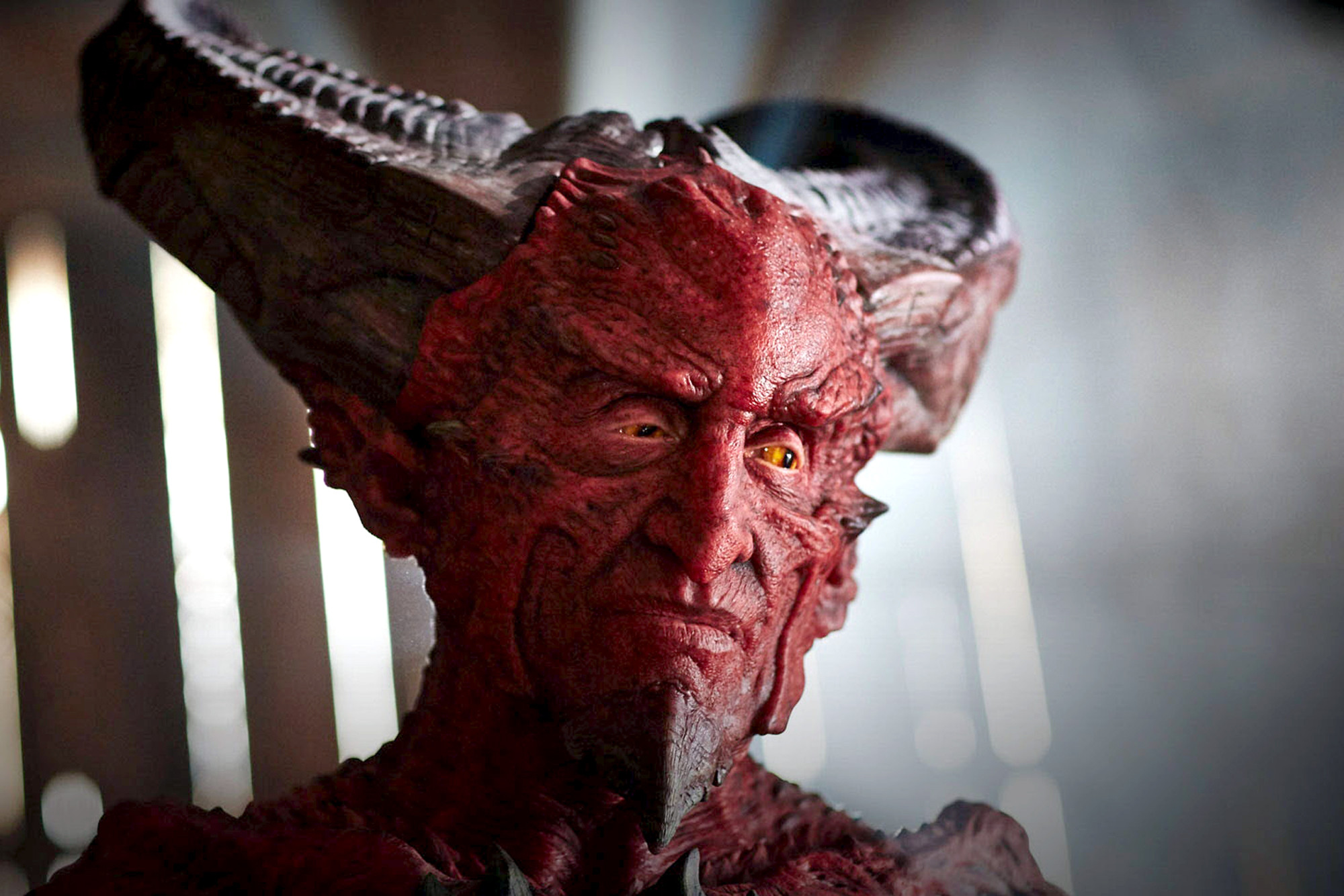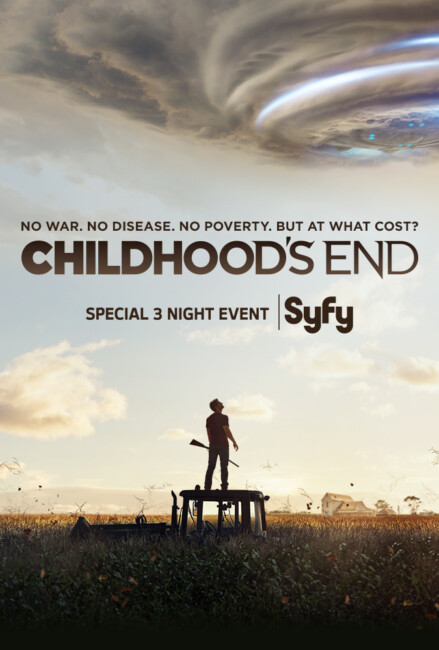USA. 2015.
Crew
Director – Nick Hurran, Teleplay – Matthew Graham, Based on the Novel by Arthur C. Clarke, Producers – Nick Hurran, John G. Lenic & Paul M. Leonard, Photography – Neville Kidd, Music – Charlie Clouser, Visual Effects Supervisor – Kevin Blank, Special Effects Supervisor – Peter Stubbs, Creature Effects Supervisors – Paul Katte & Nick Nicolaou, Production Design – Philip Ivey. Production Company – Michael De Luca Productions/Weed Road Pictures/Universal Cable Productions.
Cast
Mike Vogel (Ricky Stormgren), Osy Ikhile (Milo Rodricks), Charles Dance (Karellen), Daisy Betts (Ellie Stormgren), Ashley Zukerman (Jake Greggson), Georgina Haig (Annabel Stormgren), Charlotte Nicdao (Rachel Osaka), Yael Stone (Peretta Jones), Julian McMahon (Rupert Boyce), Colm Meaney (Hugo Wainwright, Jr), Hayley Magnus (Amy Morrel), Lachlan Roland-Kenn (Tommy Greggson), Tanc Sade (Jerry Horcross), Zahra Newman (Bridget Rodricks), Rory Bochner (Jennifer), Robert Morgan (Morton), Kenneth Random (Milo’s Grandfather))
Plot
Alien spaceships abruptly appear and hover over major cities of the world, stilling airplanes in mid-air. The aliens adopt the appearance of people’s loved ones to tell them not to worry. Missouri farmer Ricky Stormgren is taken up by an alien craft to meet with Karellen, The Overlord supervisor, and is asked to be their representative on Earth. Karellen announces that they have come to usher in a new era of peace and harmony. Karellen also states that humanity must wait fifteen years before they are ready to see the Overlords’ physical appearance. During this time, The Overlords intervene to stop warfare and violence. Despite some initial rebellion, humanity settles in to accept The Overlords and a new utopia blossoms. When the fifteen years are up, Karellen reveals his form – as resembling none other than the traditional figure of the Devil. During this time, Milo Rodricks grows up and becomes a scientist but despairs of the fact that scientific progress and enquiry is dying off under The Overlords. He conspires to find a way to sneak about an Overlord ship to visit their homeworld. It also becomes apparent that The Overlords are here to guide many newborns that are now awakening to powerful psychic powers.
Arthur C. Clarke (1917-2008) was regarded as one of the grandmasters of science-fiction during his lifetime. Growing up in England, Clarke served as a radar operator during World War II and subsequently graduated with a degree in mathematics and physics. Clarke began publishing in 1946, delivering his first novel with Against the Fall of Night (1951). Since then, Clarke produced numerous other novels, including The Sands of Mars (1951), Earthlight (1955), The City and the Stars (1956), A Fall of Moondust (1961), Dolphin Island (1963) and, most famously, Rendezvous with Rama (1973). Clarke’s greater fame with the public came when his short story The Sentinel (1951) caught the attention of Stanley Kubrick who hired Clarke to expand it into the script for 2001: A Space Odyssey (1968), which became arguably the greatest science-fiction film of all time. Clarke wrote three sequels, the first of which was filmed as 2010 (1984). The fame brought by 2001 also had Clarke hired as the host of the paranormal tv series Arthur C. Clarke’s Mysterious World (1980-2). He published numerous works and became a strong science and spaceflight advocate. He spent his life since 1956 living in Sri Lanka and was knighted in 1998.
Beyond 2001, media adaptations of Arthur C. Clarke’s work have been sporadic. Aside from Childhood’s End here, the only other Clarke work adapted to the screen has been the tv movie Trapped in Space (1994). There has certainly been interest in several other works. Most persistent of these has been an announced adaptation of Rendezvous with Rama, which passed through many hands, with rumours circulating in recent years of it as a film from David Fincher. Childhood’s End (1953) was Clarke’s third published novel and became one of his most acclaimed. It too has been mentioned as a production for many years. There was a version announced in the early 1980s as a tv mini-series under Philip DeGuere, most well known as creator/producer of tv shows like Simon and Simon (1981-9), The Twilight Zone (1985-7), JAG (1995-2005) and NCIS: Naval Criminal Investigative Service (2003– ) and as director of the tv movie version of Marvel Comics’ Dr. Strange (1978), although this never went ahead.

The unfortunate downside that Childhood’s End has in arriving in 2015 is that in the 62 years after the book’s publication much of the central imagery has been appropriated by other works. The alien taking the appearance of The Devil was heavily borrowed by Nigel Kneale’s Quatermass and the Pit (1958-9) and the later film version Quatermass and the Pit (1967), as well as the Doctor Who episode The Daemons (1972) and the animated Star Trek episode The Magicks of Megas-Tu (1973), while the classic vision of vast saucer-shaped ships hovering over the major cities of the world was borrowed by V (1983) and Independence Day (1996).
As a result, in order not to appear like a ripoff of these, the mini-series is forced to resort to lesser images – the alien ships we get here are generic and look nothing at all like Arthur C. Clarke’s highly iconic images of vast saucer ships floating over the cities (something that Clarke himself apparently took from the image of blimps in the sky over London during World War II). Even when it does come to the central plot twist of the story – the revelation that The Overlords resemble classical Devil figures – the film’s Big Reveal feels a non-event where you are reacting more to the fact that what we get is Charles Dance tricked out in some bad CGI and cheesy facial appliances than the wow moment such a revelation should have provided. Given that this is such a central image to the story, could the production not have spent a little more to make this convincing and come up with something as magnificent as say Tim Curry in Legend (1985)?
The great crime of the mini-series is that it is a classic science-fiction story that has been placed into the hands of people who give all appearance of knowing little-to-nothing about science-fiction. When it comes to genre material, director Nick Hurran’s previous outing was the silly light romantic film Virtual Sexuality (1999) wherein a computer malfunction causes a girl to manifest her ideal guy, five episodes of Doctor Who (2005– ) and the much hated mini-series revival of The Prisoner (2009), as well as sundry other work in non-genre tv. Scriptwriter Matthew Graham is mostly known for episodes of Eastenders (1985– ) – his previous genre outings were as creator of the tv series Life on Mars (2006-7) and the scripts for three episodes of Doctor Who. The chief criminal among these though is the presence of Akiva Goldsman as executive producer. Goldsman has laid a trail of atrocities every time he has either written or produced a script based on a genre work. See his scripts for the likes of Batman Forever (1995), Batman & Robin (1997), Practical Magic (1998), I, Robot (2004), I Am Legend (2007), Insurgent (2015), The 5th Wave (2016), The Dark Tower (2017) and Rings (2017), his producing Jonah Hex (2010) and the remake of Firestarter (2022), as well as directing Winter’s Tale (2014).

Like the cover version of John Lennon’s Imagine (1971) that opens Episode 2, we have a story that covers the same essential material as the original but where all the beats feel off. The script changes the novel in all manner of intelligence-insulting ways, all it would seem in order to water it down as a work that can play in Middle America. (The poster issued by the Syfy Channel for the mini-series featured the image of someone standing in the middle of a field looking at the sky holding a rifle, while the trailer tried to sell it as an alien invasion tale, even though that is explicitly what Arthur C. Clarke intended the book not to be). Ricky Stormgren goes from the United Nations Secretary General who hails from Finland to a regular farmer from Missouri – presumably because a non-American hero would switch audiences off, while the UN angle is written out most likely it would seem because conservative USA turns its nose up at the idea of being told what to do by the UN. As a result, we now get Mike Vogel as the representative of Earth. Now, I have nothing particularly against Vogel. However, in everything I have seen him in, he always comes across as the same regular working class guy without variation, someone you could sink a few beers with at the Midwestern American local – but as the equivalent of the head of the UN, this seems a role that is completely outside of Vogel’s limited range.
Nick Hurran tends to relay the mini-series in terms of effects set-pieces rather than Arthur C. Clarke’s ideas. The Overlords’ arrival on Earth is accompanied by the effect of them stilling planes in mid-air and then taking the appearance of people’s loved ones; their arrival at Mike Vogel’s farm is denoted by lots of Spielbergian light effects coming through the wall and then the entire farmhouse dissembling. None of these appear in the book and none of them have anything to do with carrying the plot other than providing a big wow effects set-piece. The scenes where the children start to come into their powers are ridiculous – they look like no more than cliches of sinister child gestalts taken from Village of the Damned (1960) – and seem there only to suggest a sinister purpose that the children never had in the book.
There are all manner of pointless changes that dumb the book down – the translation of British writer Arthur C. Clarke’s settings to rural Midwest America; the addition of the simulation of Ricky’s former wife (Georgina Haig) as a major character (who doesn’t even exist in the book), leading to a long, protracted sentimental death scene taking place in the hotel with them reminiscing about their time together; the fifty years that The Overlords make humanity wait to see their form cut down to fifteen years – presumably so that we don’t end up with a story that takes place in multiple eras and Mike Vogel can stay on until the third part without having to age (in the book, Stormgren is written out after Chapter 6, a quarter of the way into the story). One laughable piece is Milo’s smuggling aboard The Overlord ship. In the book, Clarke had him doing so inside the hollowed-out carcass of a whale, whereas here the whale is eliminated and Milo simply gets inside a vacuum-compressed transparent plastic bag where all you are left doing is wondering why The Overlords don’t turn and realise they have a body in a bag sitting in their hold in clear and open view.

The worst of these is the scene where Julian McMahon brings the Greggson family to his laboratory in Africa. In the book, Boyce is a benign figure whereas here McMahon’s Boyce is hinted at having some sinister purpose (only for him to be written out before we ever find what it is). Clarke wrote a scene where people gather in Boyce’s house and hold a seance during which Milo is able to ask and divine the coordinates of the Overlords homeworld. In the mini-series by comparison, The Overlords build a magic room in Boyce’s laboratory, which contains an ouija board that has now become a raised dais with glowing characters and is so big that it has to be stood on (we never get to learn the purpose that this serves). When activated, it beams a light of pure energy up into the sky and causes young Lachlan Roland-Kenn to jump off the roof and float a few inches from the ground, during which Milo is also able to infer the coordinates. For some reason, when Mike Vogel visits the Overlord ship, it is a perfect replica of the hotel room he stayed in with his wife on their honeymoon – which you cannot help but think is there as homage to Arthur C. Clarke’s most famous film work 2001: A Space Odyssey – but then again Hurran and Graham seem so tone-deaf to the book and science-fiction as a genre that it could just as easily not have been the case at all.
One of the other absurdities that the mini-series has is that the aliens create a utopian new world. No problems with that (and it follows on from Clarke) but in the script’s conception, this seems to mean that people now live much longer, there is no income tax and work is a thing of the past. The only thing this causes you to wonder is how does this world manage to function? If nobody works, there are no taxes and the population keeps growing without ever dying off, how does society support itself? Who produces and processes all the food that everybody eats? Who maintains and funds such things as emergency services? Who provides the buildings and tends them? Who provides medical care? Do vehicles, consumer goods, electronics and so on all magically appear out of thin air? Clarke’s answer was to have most of this conducted by robots but we are bereft of any such explanation here.
Trailer here

